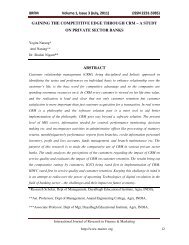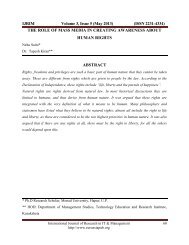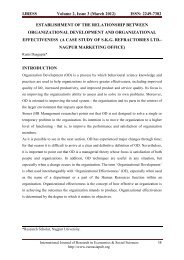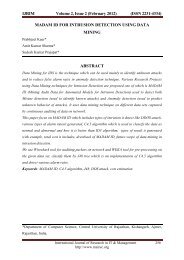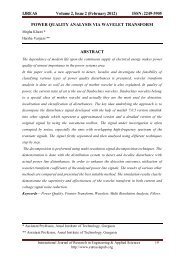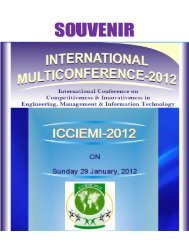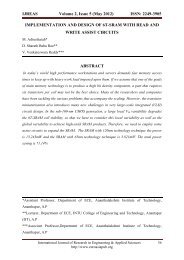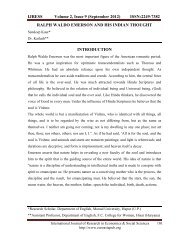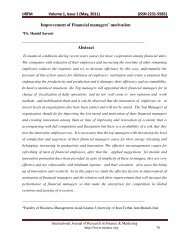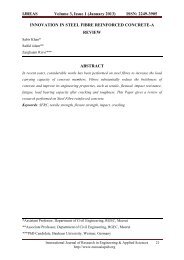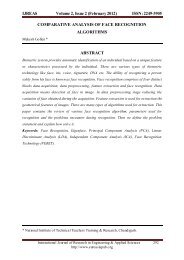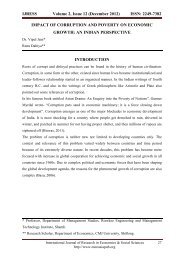IJREAS Volume 2, Issue 2 (February 2012) ISSN ... - Euroasiapub.org
IJREAS Volume 2, Issue 2 (February 2012) ISSN ... - Euroasiapub.org
IJREAS Volume 2, Issue 2 (February 2012) ISSN ... - Euroasiapub.org
Create successful ePaper yourself
Turn your PDF publications into a flip-book with our unique Google optimized e-Paper software.
<strong>IJREAS</strong> <strong>Volume</strong> 2, <strong>Issue</strong> 2 (<strong>February</strong> <strong>2012</strong>) <strong>ISSN</strong>: 2249-3905SECURITY OF MOBILE AGENTS ON NETWORK FORDISTRIBUTED DATABASEBharti Chouksey*Ravi Mohan*Rajneesh Argawal**Dushyant Sharma***ABSTRACTIn distributed dabtabase networks Mobile agent is a very important concept & utilization ofthe resources available on the connected network can be improved using mobile agentsbecause of their capability of operation on different environments, that is why, the approachis used for many network based applications like data crawling, information exchange,distributed system integrity etc. but it lacks the security aspects when applied to open networkwhere nodes cannot be classified as they are malicious or not, hence for the cases where thesecurity of data or reliability of agent become must we need some method to insure thesecurity of mobile agents. Situation becomes critical when mobile agent has travelledmultiple nodes and contains information from multiple nodes.Although many other methods are proposed by many authors but some of them required a presurvey [1], encryption of important data [2] acknowledgement schemes [3], transfer ofdummy & monitoring agents [4].Here I am proposing a scheme which not only confirms the security of data but alsoguarantees the uninterrupted operation of agent by utilizing a dummy agent and compositeacknowledgement technique as by [4] but improving the same by encryption of the data sent.This algorithm will keep two databases on each sender nodes to classify the intended nodesin two different categories. One database if of malicious nodes in which they will keep thedetails of the malicious nodes for which they will keep information related with the nodesinformed to be malicious by the dummy agents and second will keep the information of thehealthy nodes, which are found to be non malicious by the dummy agents. This will reducethe unnecessary delays in retrieving information from the distributed database networksystem and will avoid lot of security setback beforehand. Introduction of the database at thesender will be updated periodically by sending dummy packets on the intended nodes so itwill have updated information all the times. The proposed mechanism also ensures that if incase any where mobile agent is being captured by the malicious node its upstream node willInternational Journal of Research in Engineering & Applied Sciences 1251http://www.euroasiapub.<strong>org</strong>
<strong>IJREAS</strong> <strong>Volume</strong> 2, <strong>Issue</strong> 2 (<strong>February</strong> <strong>2012</strong>) <strong>ISSN</strong>: 2249-3905send the available information to the starting node so that the collected information will notbe lost up to the upstream node.Keywords: Mobile Agent, Security, Distributed database, Computing, Encryption.*Shri Ram Institute of Technology, (SRIT), Jabalpur, M.P., India.**CTA Branch, Shri Ram Institute of Technology, (SRIT), Jabalpur, M.P., India***Assistant Professor, Shri Ram Institute of Technology, (SRIT), Jabalpur, M.P., IndiaInternational Journal of Research in Engineering & Applied Sciences 1252http://www.euroasiapub.<strong>org</strong>
<strong>IJREAS</strong> <strong>Volume</strong> 2, <strong>Issue</strong> 2 (<strong>February</strong> <strong>2012</strong>) <strong>ISSN</strong>: 2249-3905previous travelling path of node and even the encryption is not required. Here, agents withdummy data are created and service monitoring agent which generates the acknowledgmentfor host which is malicious or not, but this method lacks the security in case when the agentsfails to be malicious after some time, as malicious programs can be programmed to startexecuting after a little delay in which the dummy agent decides that the node is not malicious.Therefore I am proposing to this algorithm as the information on the actual mobile agent willbe encrypted and also if the next node in path found to be malicious then it will send thecollected information to the source till the malicious node.3.0 DISTRIBUTED DATABASEA distributed database is a database in which storage devices are not all attached to acommon CPU. It may be stored in multiple computers located in the same physical location,or may be dispersed over a network of interconnected computers.Collections of data (e.g. in a database) can be distributed across multiple physical locations.A distributed database can reside on network servers on the Internet, oncorporate intranets or extranets, or on other company networks. The replication anddistribution of databases improves database performance at end-user worksites.To ensure that the distributive databases are up to date and current, there are two processes:replication and duplication. Replication involves using specialized software that looks forchanges in the distributive database. Once the changes have been identified, the replicationprocess makes all the databases look the same. The replication process can be very complexand time consuming depending on the size and number of the distributive databases. Thisprocess can also require a lot of time and computer resources. Duplication on the other handis not as complicated. It basically identifies one database as a master and then duplicates thatdatabase. The duplication process is normally done at a set time after hours. This is to ensurethat each distributed location has the same data. In the duplication process, changes to themaster database only are allowed. This is to ensure that local data will not be overwritten.Both of the processes can keep the data current in all distributive locations.Besides distributed database replication and fragmentation, there are many other distributeddatabase design technologies. For example, local autonomy, synchronous and asynchronousdistributed database technologies. These technologies' implementation can and does dependon the needs of the business and the sensitivity/confidentiality of the data to be stored in thedatabase, and hence the price the business is willing to spend on ensuring data security,consistency and integrity.International Journal of Research in Engineering & Applied Sciences 1254http://www.euroasiapub.<strong>org</strong>
<strong>IJREAS</strong> <strong>Volume</strong> 2, <strong>Issue</strong> 2 (<strong>February</strong> <strong>2012</strong>) <strong>ISSN</strong>: 2249-39052.0 EXISTING SYSTEMMobile agent protection is difficult because of a host’s complete control over executingprograms. While many approaches have been proposed to defend mobile agents frommalicious hosts, none adequately addresses every aspect of security. I have surveyed threeproposed approaches for the Neelesh kumar Panthi et al. / (IJCSIT) International Journal ofComputer Science and Information Technologies, Vol. 1 (4), 2010, 208-211 208 problem ofmobile agent protection. The three approaches are chosen because each approach is veryuniquely implemented and has strengths that other approaches do not have; we choose Partialresult authentication code approach because it can protect results from mobile agents.Computing with encrypted functions approaches is chosen because it tries to scramble codeand data together. An obfuscated code approach is chosen because it scrambles an agent’scode in such a way that no one is able to gain a complete understanding of its function.Mobile agent is software written in platform independent language or package. Because ofself mobility of software through which it can transfer to itself from one to another systemconnected in network. During this operation it can exchange the required data from eachsystem as per requirement or according to script.Because of mobility of agent it is very helpful for utilizing the network resources. But theproblem with this type of system is security of the agent, because it holds the important dataand when it executes on some platform the platform takes on the complete control of it, andhence retrieves the complete data or can temper the agent. Hence, to protect the agent dataand agent itself we are proposing a method which not only protects the data but also agent.The proposed algorithm did not required previous travelling path of node and even theencryption is not required.3. PROPOSED SYSTEMThe above algorithms, as stated in existing system, suffers the problem of delayed processingof malicious nodes and information loss when the node is found to be malicious in betweenthe path. My proposed algorithm is going to address to the above problems and will provide afeasible solution for the same. Steps in providing the secured implementation of the same areas follows:Here I am proposing a scheme which not only confirms the security of data but alsoguarantees the uninterrupted operation of agent by utilizing a dummy agent and compositeacknowledgement technique as by [4] but improving the same by encryption of the data sent.This algorithm will keep two databases on each sender nodes to classify the intended nodes inInternational Journal of Research in Engineering & Applied Sciences 1255http://www.euroasiapub.<strong>org</strong>
<strong>IJREAS</strong> <strong>Volume</strong> 2, <strong>Issue</strong> 2 (<strong>February</strong> <strong>2012</strong>) <strong>ISSN</strong>: 2249-3905two different categories. One database if of malicious nodes in which they will keep thedetails of the malicious nodes for which they will keep information related with the nodesinformed to be malicious by the dummy agents and second will keep the information of thehealthy nodes, which are found to be non malicious by the dummy agents. This will reducethe unnecessary delays in retrieving information from the distributed database networksystem and will avoid lot of security setback beforehand. Introduction of the database at thesender will be updated periodically by sending dummy packets on the intended nodes so itwill have updated information all the times. The proposed mechanism also ensures that if incase any where mobile agent is being captured by the malicious node its upstream node willsend the available information to the starting node so that the collected information will notbe lost up to the upstream node.REFERENCES1. Mei Wu, “The Application of MA-based distributed database in the measurement”School of Business, China West Normal University, Nanchong, China,Biabia220@126.com2. Ichiro Satoh. Selection of Mobile Agents. In Proceedings of the 24 th InternationalConference on Distributed Computing Systems (ICDCS’04). IEEE Computer SocietyPress, 2004.3. J. White, “Mobile Agents White Paper,” General Magic Inc., 1996.4. D. Milojici, “Mobile agent applications”, IEEE concurrency, July-Sep 1999, pp 80- 90.5. Neelesh Kumar Panthi, Ilyas Khan, Vijay k. Chaudhari “Securing Mobile Agent UsingDummy and Monitoring Mobile Agents” Department of Information Technology, T.I.T.Bhopal, India.6. Chandra Krintz, Security in agent-based computing environments using existing tools.Technical report, University of California, San Diego, 1998.7. Joshua D. Guttman and Vipin Swarup. Authentication for mobile agents. In LNCS,pages114–136. Springer, 1998.8. Neeran Karnik. Security in Mobile Agent Systems. PhDthesis, Department of ComputerScience and Engineering. University of Minnesota,1998.9. Tomas Sander and Christian F. Tschudin. Protecting Mobile Agents Against MaliciousHosts.In Giovanni Vigna, editor, Mobile Agent Security, pages 44–60. Springer-Verlag:Heidelberg,Germany, 1998.International Journal of Research in Engineering & Applied Sciences 1256http://www.euroasiapub.<strong>org</strong>
<strong>IJREAS</strong> <strong>Volume</strong> 2, <strong>Issue</strong> 2 (<strong>February</strong> <strong>2012</strong>) <strong>ISSN</strong>: 2249-390510. Bennet Yee. Using Secure Coprocessors. PhD thesis, Carnegie Mellon University,1994.International Journal of Research in Engineering & Applied Sciences 1257http://www.euroasiapub.<strong>org</strong>




